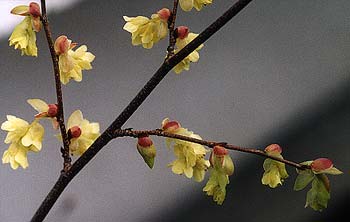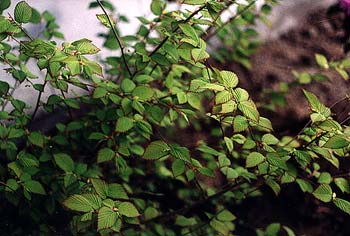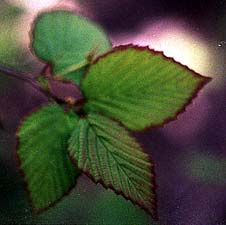 | |
| Tassells of primrose-yellow flowers lend this broadleaf deciduous shrub the name "buttercup," appearing at the cusp of spring, a mite earlier than the majority of our garden's deciduous shrubs. The buds begin to open at the tail-end of winter but are at their peak of beauty late March & early April. | |
Buttercup Winter Hazel
Corylopsis pauciflora is native of Japan & Taiwan. It gained the English name "buttercup" for the fragrant pastel or buttery-yellow blossoms that herald spring. But "Winter Hazel" (or as one word "Winterhazel") is a bit of a misnomer, & would be better named Early Spring, since it does not have Witchhazel's remarkable winter interests, which is not to say the fountaining shape of fragile-looking slender limbs is unappealing in winter.
The name "pauciflora" means "a paucity of flowers," but that refers to how many cluster together, which is not many in one spot. The flowers are otherwise profuse, occuring along the whole length of the branches, so there is no paucity at all! In Japan it is called Hyugamizuki, vis, Starwood, because the buttery-yellow blooms are sprinkled among the naked branches like stars sprinkled in the night sky.
 The early spring blooms give way to nearly-as-delicate rounded, veined & toothed hazel leaves that are strikingly beautiful from late spring through autumn. In spring each leaf is thinly fringed in reddish-purple, as shown in the leaf detail photo below, though this lovely coloration usually fades as the new leaves age into summer. It dislikes summer heat but will get through it with regular watering.
The early spring blooms give way to nearly-as-delicate rounded, veined & toothed hazel leaves that are strikingly beautiful from late spring through autumn. In spring each leaf is thinly fringed in reddish-purple, as shown in the leaf detail photo below, though this lovely coloration usually fades as the new leaves age into summer. It dislikes summer heat but will get through it with regular watering.An established winterhazel will occasionally rebloom in September. There's considerable variability & individuality so that this trait isn't predictable. Ours does rebloom early Autumn, but with fewer flowers that are closer to chartreuse rather than the vibrant yellow of Spring's pre-leaf blossoms, so that the rebloom gets rather lost among the leaves.
Its late autumn leaf colors of yellow or brown, & tend to be falling even as they turn colors. This can result in an unexciting autumn performance, so that overall it is a humble garden addition, & ideal as an occasionally showy background shrub rather than as the center of attention. But even though it does not put on an excessive display, autumn golds can nevertheless be pleasing, sufficiently so that I've included a Butternut Winterhazel Page in the Autumn Leaves Gallery, so you can judge for yourself.
 We've situated ours where it is a little hidden under a Vine Maple that protects it from winds, but at the same time it is a little bit overt against a morning-sunned white wall. Before settling on its location by the vine maple, we gave thought of planting it with a flowering quince, for both would be blooming together before leafing.
We've situated ours where it is a little hidden under a Vine Maple that protects it from winds, but at the same time it is a little bit overt against a morning-sunned white wall. Before settling on its location by the vine maple, we gave thought of planting it with a flowering quince, for both would be blooming together before leafing.It is a wonderfully restrained shrub. Ours is chest-high & slow-growing, but it could one day exceed six feet of height with a wider spread. It likes the sun or partial shade, moist acidic soil though it will tolerate soil to the alkaline edge of the pH scale, & moderate weather though it is cold hardy while at rest in winter.
Not a common nursery offering, its humbleness won't justify the price for everyone, but do give it careful consideration if apportunity arises to obtain one. In spring it's kind of like a less showy & more refined & shapely Forsythia, & there certainly is much to be said for subtlety in areas of a garden.